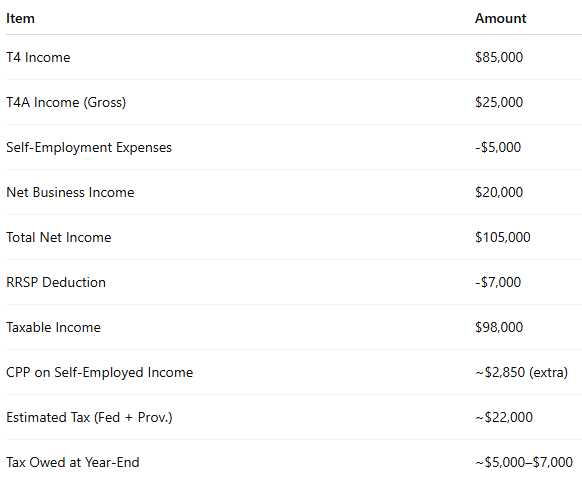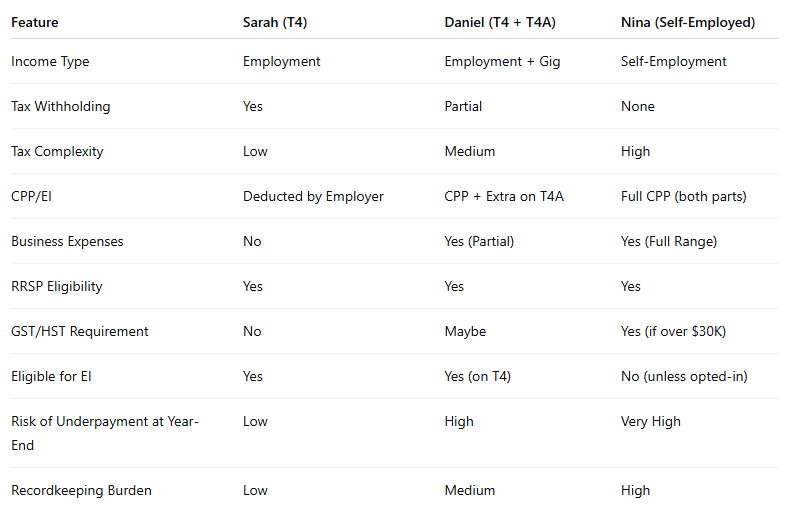Understanding How Canadian Personal Taxes Work
A Guide with Case Studies for T4, T4A, and Self-Employed Individuals
Taxes in Canada can be confusing, especially when your income comes from different sources like employment (T4), independent contracts (T4A), or your own business (self-employment). Whether you’re a salaried worker, a gig economy hustler, or a full-time entrepreneur, the way you report and pay taxes varies significantly.
In this reading, we’ll break down:
How personal taxes work in Canada
The role of income sources (T4, T4A, Self-Employment)
Deductions, credits, and filing requirements
Case studies for three different types of individuals
A detailed comparison of how taxes apply to each
📌 How Canadian Personal Income Tax Works
Canada has a progressive tax system, meaning the more you earn, the more tax you pay as a percentage of your income. You are taxed by both the federal government and the province or territory where you reside.
2024 Federal Tax Brackets:
2024 Provincial Tax Brackets (Ontario)
Each province/territory has its own tax brackets added on top of the federal rates.
🔍 Key Tax Forms:
T4: Issued by an employer showing employment income and deductions
T4A: Shows income from pensions, self-employment, commissions, or other sources
T2125: Statement of Business or Professional Activities (for self-employed individuals)
✨ Common Tax Deductions & Credits:
CPP and EI contributions (mandatory for T4)
RRSP contributions
Childcare expenses
Union dues or professional fees
Medical expenses
Canada Workers Benefit (CWB)
Home office expenses (for self-employed or remote workers)
GST/HST rebates (self-employed)
👤 Case Study 1: Sarah – Full-Time Employee with T4 Income
Profile:
Age: 32
Location: Mississauga, ON
Occupation: HR Specialist
Annual Salary: $70,000
Income Source: Only T4
Deductions: CPP, EI, RRSP ($5,000), union dues
How Her Taxes Work:
Her employer withholds tax, CPP, and EI automatically from her paycheque.
At year-end, she gets a T4 from her employer.
Sarah files a simple personal tax return (T1 General).
She claims her RRSP contributions and union dues.
She also qualifies for the Basic Personal Amount (federal ~$15,000 and Ontario ~$11,865 in 2025).
Tax Summary (Approximate):
Key Takeaways:
Simple and straightforward tax situation
Employer handles withholdings and remittances
RRSP helps reduce taxable income
Likely to get a refund or break even
👤 Case Study 2: Daniel – T4 + T4A Income
Profile:
Age: 40
Location: Calgary, AB
Occupation: IT Analyst + Freelance App Developer
Annual T4 Income: $85,000 (from full-time job)
Annual T4A Income: $25,000 (from side gigs)
Total Income: $110,000
Deductions: CPP/EI on T4, expenses from freelance work, RRSP ($7,000), home office, internet
How His Taxes Work:
Daniel receives both a T4 and a T4A.
The T4A does NOT have any tax withheld, so he is responsible for paying the tax on that income.
He completes a T2125 (Statement of Business Activities) for his T4A income to deduct business-related expenses.
He is required to pay both employer and employee portions of CPP on the net self-employment income.
Tax Summary (Approximate):
Key Takeaways:
More complex filing with both T4 and self-employment income
Needs to budget for taxes not withheld on T4A
Can deduct legitimate business expenses to reduce net income
Pays extra CPP as both “employer” and “employee” for side hustle
May want to make quarterly tax instalments
👤 Case Study 3: Nina – Fully Self-Employed (No T4 or T4A)
Profile:
Age: 36
Location: Halifax, NS
Occupation: Freelance Copywriter & Course Creator
Annual Gross Income: $80,000
Income Source: Self-employed (direct clients, course sales, no T4A issued)
Business Expenses: $15,000
Net Income: $65,000
Deductions: Home office, internet, RRSP ($5,000)
How Her Taxes Work:
Nina doesn’t receive any tax slips. She tracks her income and expenses independently.
Files T2125 to report self-employment income.
Must pay both parts of CPP (~10.9%) on net income.
No EI unless voluntarily enrolled.
Must track and remit GST/HST if she crosses the $30,000 threshold.
May be eligible for Canada Workers Benefit (CWB) or business-use-of-home deduction.
Tax Summary (Approximate):
Key Takeaways:
Most tax and legal responsibilities fall on her
Needs good bookkeeping and cash flow management
Responsible for CPP contributions, GST/HST, and year-end tax bill
Can claim a wide range of business-related deductions
Strong candidate for eventual incorporation if income increases
💡 Comparing All Three Individuals
✅ Tips for Each Type of Taxpayer
For T4 Earners:
Maximize your RRSP and claim all available credits.
Use online tools like SimpleTax or TurboTax to file.
Consider increasing source deductions if you often owe taxes.
For T4 + T4A Earners:
Set aside 25–30% of T4A income for taxes.
Track all business-related expenses (home office, phone, subscriptions).
File your T2125 accurately.
Consult an accountant about quarterly instalments if income is consistent.
For Self-Employed Individuals:
Open a separate business bank account and use cloud-based bookkeeping (like QuickBooks or Wave).
Keep all receipts and invoices.
Set aside 30–35% of income for taxes and CPP.
Register for GST/HST once you cross the $30K threshold.
Consider incorporation once your net income exceeds $80K–$100K/year consistently.
✍️ Conclusion
Understanding how Canadian personal taxes work is critical no matter what kind of income you earn. While salaried employees have a simpler process, individuals who receive T4A or are fully self-employed carry more responsibility—but also enjoy more opportunities for tax deductions and planning.
As the gig economy grows and more people operate side hustles or full-time businesses, being proactive about taxes is not just good practice—it’s essential.
Whether you’re like Sarah, Daniel, or Nina, make sure you:
Understand your income types
Track your deductions
Pay attention to CPP/EI obligations
File accurately and on time
Work with a tax professional if needed










